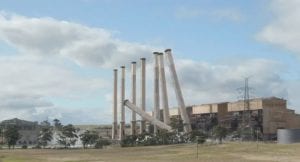With the Grant King led review into Australia’s climate policies advocating for new incentives for big industries to cut emissions, is the Morrison government set to finally embrace an emissions trading scheme?
Following the release of the review recommendations on Tuesday, the Morrison government is now proposing to reward industrial emitters for achieving emissions reductions.
Using the pre-existing Safeguard Mechanism, the Morrison government will award a new form of carbon permit, “Safeguard Mechanism Credits” (SMCs), to companies that cut emissions below their Safeguard Mechanism caps.
Big emitters will be able to sell or trade these credits to the government, or to other emitters, for cash.
The King Review recommended that the “SMCs could be used to meet compliance obligations under the Safeguard Mechanism, purchased by the private sector, or purchased by the Government through a new arrangement under the Climate Solutions Fund.”
Despite the proposal having all of the characteristics of a baseline-and-credit emissions trading scheme, the Morrison government will not admit that it was effectively introducing a form of emissions trading.
Instead, the Morrison government will adopt what was described in the final report of the Grant King review into emissions policies as a “‘below-baseline crediting arrangement”.
It is an exercise in semantics, and emissions reduction minister Angus Taylor would not concede it was effectively a form of emissions trading in an interview with ABC Radio National.
“This is just about making sure that Australian manufacturing has the right incentives in place to reduce emissions,” Taylor told ABC’s AM program. “There is a Safeguard Mechanism, it penalises manufacturers if they raise their emissions in a way that is out of line with that mechanism.”
“But there was no incentive, no carrot if you like, for them to go further than that. This simply introduces a carrot for them to be able to reduce their emissions beyond that baseline.”
“What is new here, is that if you are a manufacturer, and you can deploy the very best technology to reduce your emissions per unit of output down to a very low level, you should be rewarded for that.” Taylor added.
Even the King Review avoided describing its own proposal as a form of emissions trading.
“The crediting mechanism would not be an offset scheme; it would be a low-emissions technology deployment incentive scheme, not unlike the [Renewable Energy Target]”, the review report says.
Emissions trading, and carbon pricing more generally, has been the Voldemort of Coalition climate policy. Everyone knows that it exists, but none will dare speak its name.
Emissions trading and carbon pricing became an unspeakable term after Tony Abbott won election in 2013 on the basis of ‘scrapping the carbon tax’.
But no matter the politics, emissions pricing remains the climate change policy of choice for experts and was said so bluntly by former Treasury secretary Ken Henry in an interview with ABC’s Four Corners shown on Monday.
“The question you should be asking yourself is what is the least economically damaging way of achieving that cap on national emissions? And the answer to that question, and everybody will tell you this, is an emissions trading scheme,” Henry told Four Corners.
The Safeguard Mechanism was first conceived under the Abbott government and was promoted as a way of setting a cap on greenhouse gas emissions from major industrial emitters.
In practise, however, the Safeguard Mechanism was designed to be a negligible impost on major emitters, as generous caps, and an ability for companies to dodge requirements to offset emissions increases, having left the scheme relatively weak.
The weak caps imposed on emitters under the Safeguard Mechanism still represent the fundamental flaw of the policy, with the Investor Group on Climate Change (IGCC) calling for tighter caps, which it says would work to stimulate investment in emissions reductions.
“The structural weaknesses in the Climate Solutions Package remain unaddressed. If Australia is to meet its short and long-term obligations under the Paris Agreement, caps on industrial emissions under the safeguards will need to be tightened over time or significantly larger amounts of taxpayer’s money will need to be committed to purchase emissions reductions at higher prices,” IGCC CEO Emma Herd said.
“Tightening the safeguard baselines would accelerate private sector demand for abatement, removing the need for governments to purchase on budget significant emissions cuts.”
The Carbon Markets Institute (CMI), which generally welcomed an expansion of Australia’s carbon market opportunities, expressed the same concerns around the underlying weaknesses in the Safeguard Mechanism.
“There are a number of welcome steps in the King Review that have been supported by the Government. There will be devil in the detail that will need to be carefully tracked through the consultation processes,” CMI CEO John Connor said.
“CMI supports the ability for companies to extend their trade in carbon reduction credits within the Safeguard Mechanism. However, allowing this without proper constraints and declining Safeguard baselines, could jeopardise robust carbon markets as well as clean technology development and deployment in the carbon farming and other decarbonisation industries,” Connor added.
The plan has also attracted the criticism of environmental groups, which see the proposal to issue a new form of carbon credits to industrial emitters as another attempt by the Morrison government to channel taxpayer money into polluting industries.
“The Coalition’s plan to pay polluters defies logic and has already been proven completely ineffective. The Emissions Reduction Fund has been a comprehensive failure and the Coalition is throwing good money after bad by stubbornly refusing to accept that it has been handing out billions of dollars for the country’s biggest polluters to increase, not decrease their carbon pollution,” Greenpeace Australia Pacific head of research and investigations Dr Nikola Casule said.
“This is just another transparent excuse to gift more taxpayer money to the climate-destroying fossil fuel industry instead of putting people first in the post-Covid recovery.”
In response to the King Review, the Morrison government will also introduce new measures to mature Australia’s carbon markets, including the introduction of “exchange traded” markets for carbon units to encourage more active trading.
The King Review also recommended the introduction of a nationally consistent “emissions exchange rate” for Large-scale Generation Certificates issued under the Renewable Energy Target, which would tag renewable energy purchases with a quantifiable amount of emissions reduction.
While stopping short of allowing LGCs to be used under the Emissions Reduction Fund or the Safeguard Mechanism, the “emissions exchange rate” does open up a pathway for renewable energy certificates to be used as a form of emissions offset.
RenewEconomy and its sister sites One Step Off The Grid and The Driven will continue to publish throughout the Covid-19 crisis, posting good news about technology and project development, and holding government, regulators and business to account. But as the conference market evaporates, and some advertisers pull in their budgets, readers can help by making a voluntary donation here to help ensure we can continue to offer the service free of charge and to as wide an audience as possible. Thank you for your support.










